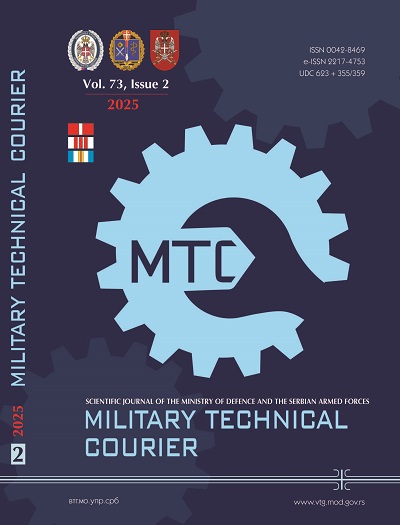Solving a damped spring-mass system via the MA-simulation function
Abstract
Introduction/purpose: In an interesting article, Perveen & Imdad (2019) introduced the notion of an MA-simulation function, and utilized it to prove the existence of a fixed point for a self mapping through α-admisibilty and the continuity of the self-map in a fuzzy metric space. The purpose of this paper is to establish a unique fixed point theorem for an MA-contractive mapping by relaxing the condition of continuity and α-admissibilty of the map in a fuzzy metric space. As an application of our result, we study the existence and uniqueness of the solution to the damped spring-mass system. The article includes an example which shows the validity of our results.
Methods: The fixed point method with an MA-simulation function was used.
Results: A unique fixed point for a self map in a fuzzy metric space is obtained.
Conclusions: A fixed point of the self maps is obtained without the continuity and α-admissibility of the self map via the MA-simulation function. Also, the existence and uniqueness of the solution of a damped spring-mass system in the setting of a fuzzy metric space is obtained.
References
George, A. & Veeraman, P. 1994. On some results in fuzzy metric spaces. Fuzzy Sets and Systems, 64(3), pp.395-399. Available at: https://doi.org/10.1016/0165-0114(94)90162-7.
Grabiec, M. 1988. Fixed points in fuzzy meric spaces. Fuzzy Sets and Systems, 27(3), pp.385-389. Available at: https://doi.org/10.1016/0165-0114(88)90064-4.
Gregori, V. & Miñana, J.-J. 2014. Some remarks on fuzzy contractive mappings. Fuzzy Sets and Systems, 251, pp.101-103. Available at: https://doi.org/10.1016/j.fss.2014.01.002.
Gregori, V. & Sapena, A. 2002. On fixed-point theorems in fuzzy metric spaces. Fuzzy Sets and Systems, 125(2), pp.245-252. Available at: https://doi.org/10.1016/S0165-0114(00)00088-9.
Jain, S., Jain, S & Jain, L.B. 2009. Compatible mappings of type (β) and weak compatibility in fuzzy metric spaces. Mathematica Bohemica, 134(2), pp.151-164. Available at: https://doi.org/10.21136/MB.2009.140650.
Khojasteh, F., Shukla, S. & Radenović, S. 2015. A new approach to the study of fixed point theory for simulation functions. Filomat, 29(6), pp.1189-1194. Available at: https://doi.org/10.2298/FIL1506189K.
Kramosil, I. & Michálek, J. 1975. Fuzzy metrics and statistical metric spaces. Kybernetica, 11(5), pp.336-344 [online]. Available at: http://dml.cz/dmlcz/125556 [Accessed: 02 September 2024].
Mihet, D. 2008. Fuzzy ψ-contractive mappings in non-Archimedean fuzzy met- ric spaces. Fuzzy Sets and Systems, 159(6), pp.739-744. Available at: https://doi.org/10.1016/j.fss.2007.07.006.
Mihet, D. 2010. A class of contractions in fuzzy metric spaces. Fuzzy Sets and Systems, 161(8), pp.1131-1137. Available at: https://doi.org/10.1016/j.fss.2009.09.018.
Perveen, A. & Imdad, M. 2019. Proving new fixed point results in fuzzy metric spaces employing simulation function. Journal of Intelligent and Fuzzy Systems, 36(6), pp.6493-6501. Available at: https://doi.org/10.3233/JIFS-182873.
Saha, P., Choudhury, B.S. & Das, P. 2016. Weak Coupled Coincidence Point Results Having a Partially Ordering in Fuzzy Metric Spaces. Fuzzy Information and Engineering, 8(2), pp.199-216. Available at: https://doi.org/10.1016/j.fiae.2016.06.005.
Schweizer, B. & Sklar, A. 1983. Probabilistic Metric Spaces. Mineola, New York: Dover Publications. Inc. ISBN: 0-486-44515-3.
Tirado, P. 2012. Contraction mappings in fuzzy quasi-metric spaces and [0, 1]- fuzzy posets. Fixed Point Theory, 13(1), pp.273-283 pp.273-283 [online]. Available at: https://www.math.ubbcluj.ro/~nodeacj/vol_13(2012) no1.php [Accessed: 02 September 2024].
Wardowski, D. 2013. Fuzzy contractive mappings and fixed points in fuzzy met- ric spaces. Fuzzy Sets and Systems, 22, pp.108-114. Available at: https://doi.org/10.1016/j.fss.2013.01.012.
Zadeh, L.A. 1965. Fuzzy Sets. Information and Control, 8(3), pp.338-353. Avail- able at: https://doi.org/10.1016/S0019-9958(65)90241-X.
Copyright (c) 2025 Shobha Jain, Stojan N. Radenović, Shishir Jain

This work is licensed under a Creative Commons Attribution 4.0 International License.
Proposed Creative Commons Copyright Notices
Proposed Policy for Military Technical Courier (Journals That Offer Open Access)
Authors who publish with this journal agree to the following terms:
Authors retain copyright and grant the journal right of first publication with the work simultaneously licensed under a Creative Commons Attribution License that allows others to share the work with an acknowledgement of the work's authorship and initial publication in this journal.
- Authors are able to enter into separate, additional contractual arrangements for the non-exclusive distribution of the journal's published version of the work (e.g., post it to an institutional repository or publish it in a book), with an acknowledgement of its initial publication in this journal.
- Authors are permitted and encouraged to post their work online (e.g., in institutional repositories or on their website) prior to and during the submission process, as it can lead to productive exchanges, as well as earlier and greater citation of published work (See The Effect of Open Access).

